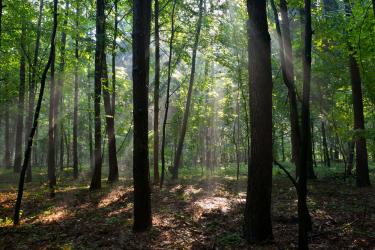Creating and Caring for Young Forests
Many of the activities that woodland owners do to benefit from and care for their woods come with an added bonus: they create and maintain young forests.
Prescribed burning, disking (shallow tilling), mowing, and timber harvesting all contribute to the conditions young forests need to take root.
When starting a young forest, the key is to remove all or a significant portion of the forest canopy. That means your harvesting method should clear the land of large, mature trees and any older vegetation growing between those trees, to leave you with open, sunny spaces where young trees can sprout. Shelterwood harvests, seed-tree harvests, and clearcuts are all harvesting methods that can help you accomplish that.
- Clearcuts remove most or all of the woody vegetation in a small area of your woods.
- Seed-tree harvesting is like a small-scale clearcut, except that some seed-bearing or stump-sprouting trees (if you have them) are left standing to produce the next generation of trees.
- Shelterwood harvesting is a kind of gradual or “slow-motion” clear cut. It selectively removes some big trees and all the understory vegetation, allowing just enough light and space for the next generation of trees. As the young trees become established, more or all of the mature trees are removed to leave you with an even-aged young forest.
These harvesting methods mimic some of the catastrophic disturbances, like wildfires and windstorms, that used to create and renew young forests. After a harvest, you may need to plant trees and native shrubs to get things started, depending on the conditions of your site.
Once you have a young forest, you have to keep it young—that is, you have to maintain the unique qualities that make them so valuable as habitat. Some ways to do that are:
- Repeated harvesting. Harvesting again as your trees mature will maintain the open, sunny conditions that favor young forests.
- Discing and mowing. Disturbing the soil through shallow tillage (also known as “discing”) and mowing check the older growth on your land while stimulating the regrowth of grasses and forbs and the resprouting of many woody species.
- Burning. Frequent fires were a natural part of the cycle that gave rise to young forests, and reintroducing fire can help to restart that cycle in your own woods. Like discing, mowing and harvesting, controlled burning knocks back older growth to let younger trees and plants thrive.
If done right, these activities can create young forest while enhancing the health of the rest of the landscape—and even providing an economic benefit. Here’s what you need to know to start your young forest right.
How can I get more tips?
It’s simple! Enter your email below.

